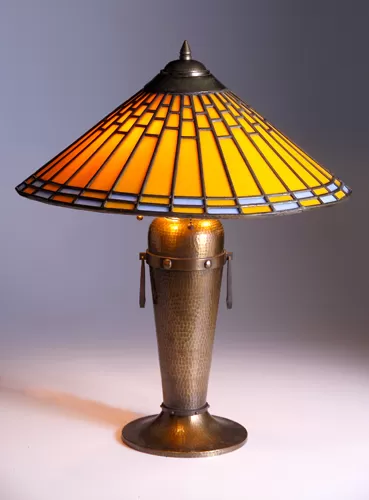Collecting Roycroft Lamps
by Bruce Johnson
Editor note: this article has been republished. Original date of publication: June 17th, 2013.

Roycroft Table lamp.
Ask anyone about Arts and Crafts lighting and the name Roycroft is quickly going to enter the conversation.
In the Summer 2013 issue (#78) of American Bungalow magazine, collector and website author David Kornacki compiled the most comprehensive study of Roycroft lamps that I have ever read, along with an impressive array of color photographs and vintage Roycroft advertisements.
David points to 1913 as the turning point for the Roycroft Copper Shop, starting an “era that would last for more than 15 years and provide today’s collectors with numerous examples of more than 20 different lamp models to pursue and collect.” Completion of the Grove Park Inn’s 1913 commission for hundreds of Roycroft table lamps and ceiling lights financed the expansion of the Copper Shop and enabled them to become the leading producer of hammered copper Arts and Crafts lamps for the next two decades.
From 1913 through 1920, the Roycroft Copper Shop focused on lamps that combined a hammered copper base with a hammered shade with or without mica panels. The largest, model #904 (top picture), designed by Victor Toothaker shortly after he completed the Grove Park Inn commission, is 24 inches tall and features three light sockets, stained glass, a flared circular base, and riveted strap handles. It was produced for only four years before being replaced by a smaller, less expensive version.
More available for today’s typical collectors are the various “helmet shade” table lamps that the Roycrofters made in different heights and styles of bases, each with a solid copper shade. The shades directed all of the light down onto the hammered copper base, highlighting the craftsmanship but providing no light for reading! The addition of mica panels to some of the shades did allow more light to escape, but, as collectors realize today, these lamps are still designed more for effect than practicality (lower picture).
But they are a thing of beauty!
In the 1920s the Roycrofters solved this problem by combining their hammered copper bases with blown glass shades from Steuben, a division of the Corning Glass Works company. Beginning in 1925, the Roycrofters offered a less expensive, but nowhere near as attractive table lamp with a vellum or parchment shade. Since Karl Kipp had replaced Victor Toothaker as foreman around 1915, it is believed that Kipp played a major role in the design of the later Roycroft lamp bases.
At the close of his American Bungalow article, David Kornacki provides a sidebar entitled “Collecting Roycroft Lamps,” that lists the various lamps and rates their availability today. He also provides tips on what any collector should know before purchasing a Roycroft lamp.
For more information on the article, go to http://www.AmericanBungalow.com.
David’s website is http://www.RoycroftCopper.com.
If you’d like to see examples of Roycroft and other Arts & Crafts lighting for sale, come to the National Arts and Crafts Conference and Shows at the Grove Park Inn.
The National Arts and Crafts Conference website
